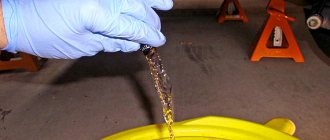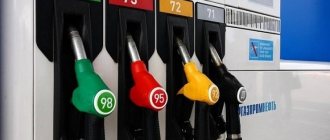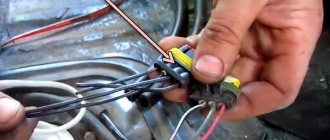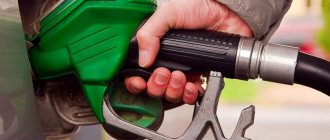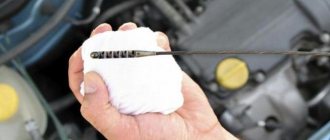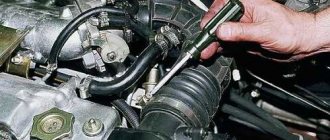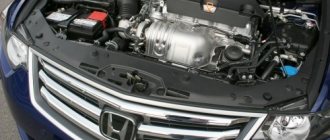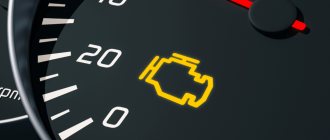Running out of gas? No problem!
Forgetfulness is far from the only reason why you can be left without fuel on the road.
Unpredictable traffic jams in our cities in terms of location and duration can leave even the most prudent driver without fuel! Be that as it may, you can always order urgent delivery of gasoline or diesel fuel. And the cause of your problem is not at all important: the important thing is that there is an opportunity to solve the problem. If you need to refuel right here and now, far from a gas station, then a mobile gas station will come to your aid. The roadside assistance service includes:
As a rule, in addition to fuel delivery, roadside assistance services offer drivers other services. These include on-site tire fitting (changing a wheel or urgent repair of tire damage), charging the battery, unlocking the steering wheel, opening the car, etc.). And if you can’t solve the problem on the spot, you will be assisted in calling a tow truck.
How to find out that a car has stalled due to lack of fuel
Stopping the power unit can occur for a variety of reasons. A modern engine is a complex technical device consisting of thousands of parts. The failure of any of them is fraught with serious troubles, and diagnosing such malfunctions can be considered as an independent and extensive topic.
Nevertheless, in the vast majority of cases, it is quite easy to determine that the fuel has run out. The fact is that gasoline or diesel fuel does not suddenly run out (we will not consider cars running on gas, since in an emergency they can also run on gasoline). Every car has a light that lights up as soon as the amount of fuel in the tank decreases to a certain critical level. But in this case, the driver always has a certain reserve of power, allowing him to solve the problem before it arises.
But... It is possible that the indicator simply burned out. In the end, the warning signal may simply not be noticed (it will not light for long, allowing you to drive about 10-15 kilometers at a good speed, which is about 6-10 minutes).
But there are other signs indicating that the fuel in the gas tank remains at the bottom. First of all, this will be indicated by unstable operation of the motor, the appearance of third-party noise, you can hear “fingers” knocking, although this has not been observed before. This happens due to the fact that the gas pump pumps the remaining fuel into the fuel system along with water and suspended matter accumulated at the bottom of the container.
Jerking of the car with the accelerator pedal in the same position, loss of smooth movement, decreased throttle response of the power unit are also indirect symptoms of a low fuel tank. Many car owners know what to do if they run out of gasoline/diesel fuel on the highway, but we have no doubt that not all do. It should be taken into account that existing knowledge may not be enough to solve the problem, so it makes sense to provide the most common and effective ways to eliminate it.
How does a car behave if it runs out of gas?
In general, you initially need to take a closer look at the sensor, since in most cases it blinks and notifies you that the fuel will soon run out. However, if the car is driving very fast, then such a signal only works for 6-10 minutes. Accordingly, the motorist may simply not be able to see the sensor signal. There is a possibility of the light bulb burning out, so the driver will not be notified that the fuel will soon run out.
How does a car behave if it runs out of gas?
- The sensor reports low fuel level
- The car drives on a flat surface, but begins to stall when you reach a downhill or uphill slope
- Fingers begin to knock, and there is extraneous noise in the engine
- The spark plugs become difficult to operate and noise appears.
- The gas pedal is fixed in the same position. In this case, the car may hesitate and twitch.
- The engine speed may periodically drop and its power decreases
Refueling a car
How to get to a gas station if you run out of gas
If you need to replenish your fuel reserves at the nearest gas station, you can use one of the described methods. Each of them has both its advantages and disadvantages, which need to be considered in more detail to choose the best one.
Stopping an old car
A Zhiguli is best suited for this purpose. Cars of this brand are found quite often on city highways. You only need to have a hose with you (from 1.5 m), with which you can drain flammable liquid from an old car.
The method will not help if the car owner independently installed a mesh filter in the neck of the gas tank.
To transfer liquid from one machine to another, in addition to the hose, you will need some kind of container. The fact is that it can be difficult to carry out the procedure using only a hose: the cars need to be placed sideways to each other, which will require free space on the road; The gas tank levels in both cars must be the same, which is not always possible.
This method is recognized by motorists as the simplest among all available. Despite this, there are a number of disadvantages that force you to choose a different method. Among the disadvantages of the procedure for draining gasoline from an old car, the following aspects are highlighted:
Using this method makes it as easy as possible to get enough liquid to get to the gas station.
Draining fuel from a foreign car
The procedure is similar to draining fluid from an old car. There are several options for implementing the method - a hose and a gas pump.
If a hose is used, it is necessary that there is a mesh with a diameter of 6 mm in the filler neck. If this parameter is suitable, it is worth trying to overcome the complex geometry and large length of the neck.
The disadvantage of this method is the small probability of meeting a driver from whose car a flammable liquid can be drained. In addition, the gas tank of a foreign car may have a special membrane and mesh that is responsible for filtering debris.
Another option that allows you to drain gasoline from a foreign car is to use a gas pump. Not every driver will agree to use this device. The fact is that you need to remove the nut that connects the fuel line and the fuel pump.
The undeniable advantage of the method is the ability to drain fuel from a foreign car. The disadvantage is the need to carry a device with you. In addition, as mentioned above, not every driver will be ready to undergo such a procedure.
Refilling with other flammable liquid
Modern cars are demanding on the fuel that is poured into them; there is an option to use a different liquid to drive about 10-15 km.
What to do if after refueling the car still does not start
It often happens that after filling the gas tank with fuel, the car still does not start. This may be a problem that can be easily fixed. First you need to determine what is the reason that the car does not start.
First of all, check the condition of the electrical wiring and contacts of the starter and ignition coil.
Spark plugs can be flooded by pressing the ignition pedal too hard.
The car may not start if there is carbon deposits and cracks on the spark plug housing.
The reason why the engine does not start may be frost or water on the air intake pipe or in the exhaust pipe. This happens when the driver forgets to turn on the fuel or does not turn off the high gear.
If, when the ignition is turned on, the fuel pump starts to idle, the gasoline may have run out at the injection site. In this case, you most likely will not be able to solve the problem yourself.
You also need to take into account whether the gasoline has completely run out. If the tank was completely drained, this could lead to a number of unpleasant consequences, for example:
For these reasons, it is not recommended to constantly turn on the ignition again and again. In this case, it is worth calling a tow truck so as not to cause more damage to the car.
Reason #3 – Lack of spark
To start the engine, two conditions must be met:
- Setting something on fire is fuel, we’ve already dealt with that;
- To set fire to something means the presence of a spark. Let's talk about this.
It is necessary to check sparking at the spark plug electrodes.
To do this, unscrew the spark plug and put an armor wire or ignition coil on it. We place the threaded part of the spark plug on the engine body and “twist” the starter.
If there is a spark, then everything is in order, if not, then there may be several reasons:
- The spark plug has failed.
If there was only one, the engine would fail, but since it won’t start, we check all the others. Carbon deposits, oily deposits, damaged or melted electrodes may be the cause. - Armored wires.
Due to old age, their insulation may become damaged, part of the current will go to the “side”, and there will be no spark. - Ignition coil or individual ignition coils.
In the first case, it may be a real problem starting the engine. In the second, all the coils must be “covered with a copper basin” at the same time, which is unlikely. So let's move on. - Ignition module.
If there is no spark on all the candles, it means that the “end” has come for him.
What is useful to have in the trunk
If you have a number of devices with you, this unpleasant situation, like many others, can be avoided. In addition, these tools take up minimal space and can be useful at any time.
First of all, you should place a metal container, a tow rope and hoses of different thicknesses in the trunk. This will help solve the problem when it occurs. In addition, the driver will be sure of what to do if he runs out of gas.
When planning a trip for short and, especially, long distances, you need to calculate whether the available gasoline is enough to get to your destination and back. Before departure, you need to refuel and, if necessary, take a metal container with fuel with you.
Source
Pashok21074 › Blog › What to do if you run out of gas in the middle of the road
If on the road for some reason you missed the moment when the fuel ran out and the car stalled, then the very first thing to do is to calm down and stop panicking. The situation is not hopeless, you just need to carefully calculate all the options for getting out of it.
Despite the fact that modern cars are equipped with all kinds of electronics that indicate possible problems with fuel, anything can happen. And the situation when gas suddenly runs out in the middle of the road is not as rare and absurd as it might seem at first glance.
If your car’s gas tank suddenly runs out of fuel in the middle of the road, then first of all you need to suppress panic attacks and really assess your own capabilities. In an area with well-developed infrastructure, finding a gas station is not a big problem. You can get to it either on foot or by stopping a friendly motorist. The situation can be helped by clearly expressed signs of distress: an open hood, an empty canister in the driver’s hands - any motorist will understand that the person needs help.
A problem may arise at the gas station itself if the driver, left without gasoline, does not have a metal canister in stock. For fire safety reasons, dispensing fuel into plastic cans is prohibited, so there are few ways out of the situation.
The driver will either have to purchase a metal canister (it is not a fact that they are on sale at the nearest gas station); or look for a fellow traveler who owns such a canister; or ask to have your car towed to the nearest gas station. If the stalled car has an automatic transmission, then the option of towing over long distances should be excluded.
If a metal canister is available and you managed to get to the gas station, the next problem to be solved is refueling the car. You cannot simply pour gasoline from a canister into a gas tank; you will need a container with a neck or a funnel. Therefore, when buying gasoline, it is worth purchasing a bottle of mineral water. By cutting off the neck of this bottle, you can get a good funnel through which you will pour gasoline into the empty car tank.
But it is important to remember that most gas tanks are equipped with a special membrane that makes it difficult for thieves to drain fuel. This membrane will prevent gasoline from entering the neck of the tank, so you will need to use some carefully cleaned twig inserted into an improvised funnel - the branch will bend the membrane and allow fuel to be poured.
Mobile communications and Internet
If there is no one around a car in distress who wants to come to the rescue, then do not forget about the limitless possibilities provided by a mobile phone and the Internet.
If calling your friends from the list in the phone book did not bring the desired results, and the numbers of technical assistance services on the roads are unknown, then you can leave a mark on Yandex maps with a description of the incident - it is possible that those passing by will be imbued with the situation and come to help.
What to do if you run out of gas
Rule number one is to get out of the car and keep a safe distance from it. If you run out of gas in the middle of the road, immediately turn on your warning lights for clarity - at night and even during the day. This warns other drivers that the car is immobilized.
Then carefully move your car to a safe place. Place the vehicle in neutral and check if it is safe to drive out of it. When it is clear, carefully get out of the car next to the driver's seat and push the car to the side of the road.
Find your location
If the car is located in the middle of nowhere and it is not known exactly how far away the nearest gas station is, you will have to determine the exact location. Navigation applications, such as Yandex navigator, will help perfectly with this. If there is no connection, you should immediately look for road signs or, if it is dark, nearby lights that may indicate an exit leading to the nearest gas station.
Call for help
To avoid running out of gas on a long trip, you need to install an app on your phone to find gas stations along your route. Determine in advance when and where you plan to stay. This will prevent you from missing the last gas station and ensure fast and safe delivery to your destination.
It's also best not to trust your fuel gauge. Even if it says that there is enough fuel left, these numbers do not always decrease consistently.
There are a few things you can do to save fuel when it matters most: Turn off the air conditioning, stereo, and all other electrical devices such as charging your phone. Finally, keep your windows rolled up to reduce wind resistance on your car.
Source
Reason #1 – No fuel
This is one of the trivial reasons that people may admit. There can be two cases:
- Forgot to fill up or hoped to make it to the nearest gas station;
- The fuel level sensor in the gas tank does not work.
The first reason is clear - confusion, forgetfulness and hope for the Russian “maybe”. The second one is a little more difficult.
It is not uncommon for the fuel level indicator float to fail.
There is no need to beat yourself in the chest:
“This never happens to me
.
You may not know this. Once we filled the tank full, we constantly looked at the gas quantity indicator, but did not notice that it stood in one place. One fine moment you will stand somewhere in a field with “half” a gas tank and you will start yelling that something has broken and your car has stalled - but the tank is empty
.
How to check
On carburetor cars, you can look at the fuel filter sump
. They are usually transparent. If there is gasoline in it, then the reason is not an empty tank.
If you have a fashionable fine filter without a sump, then stock up on a small container. Remove the fuel hose to the filter. We direct it into the prepared container so as not to fill everything with fuel. Let's see if something is flowing from it, then there is gasoline, if it is dry, you have pumped the gas tank dry.
On injection machines.
There is a screw on the fuel rail to control the fuel pressure. We unscrew it a few turns, place a container and a rag under it. We ask an assistant or passenger to turn on the ignition. The fuel pump should start working.
What to do if your car runs out of gas on the highway
The road often presents various surprises. Inexperienced drivers are especially often caught off guard, for whom even replacing a flat tire is a real challenge. And the problem is not always solved in a simple way. An empty gas tank is one of the most common reasons for stopping a car on the road. However, even for an experienced motorist the question “What to do if you suddenly run out of gas?” in some cases it becomes relevant. Let's try to describe all possible methods for solving this eternal problem.
How to find out that a car has stalled due to lack of fuel
Stopping the power unit can occur for a variety of reasons. A modern engine is a complex technical device consisting of thousands of parts. The failure of any of them is fraught with serious troubles, and diagnosing such malfunctions can be considered as an independent and extensive topic.
Nevertheless, in the vast majority of cases, it is quite easy to determine that the fuel has run out. The fact is that gasoline or diesel fuel does not suddenly run out (we will not consider cars running on gas, since in an emergency they can also run on gasoline). Every car has a light that lights up as soon as the amount of fuel in the tank decreases to a certain critical level. But in this case, the driver always has a certain reserve of power, allowing him to solve the problem before it arises.
But... It is possible that the indicator simply burned out. In the end, the warning signal may simply not be noticed (it will not light for long, allowing you to drive about 10-15 kilometers at a good speed, which is about 6-10 minutes).
But there are other signs indicating that the fuel in the gas tank remains at the bottom. First of all, this will be indicated by unstable operation of the motor, the appearance of third-party noise, you can hear “fingers” knocking, although this has not been observed before. This happens due to the fact that the gas pump pumps the remaining fuel into the fuel system along with water and suspended matter accumulated at the bottom of the container.
Jerking of the car with the accelerator pedal in the same position, loss of smooth movement, decreased throttle response of the power unit are also indirect symptoms of a low fuel tank. Many car owners know what to do if they run out of gasoline/diesel fuel on the highway, but we have no doubt that not all do. It should be taken into account that existing knowledge may not be enough to solve the problem, so it makes sense to provide the most common and effective ways to eliminate it.
What not to do to quickly run out of gas
There are several main reasons that lead to problems with fuel:
- Constantly running engine. It's one thing to turn on the engine to warm up the car; it's quite another to leave a running car in the parking lot and leave it for several hours. The same applies to hours-long traffic jams.
- Lack of a spare fuel canister in the trunk. A canister can always help out and prevent the system from breaking down. When the gas runs out, the car does not start because the fuel system has dried out. You can avoid this with a few liters of fuel.
- Excessive self-confidence when traveling long distances by car. Sometimes there can be hundreds of kilometers between two cities, so there will always be a chance of not calculating the amount of fuel and getting stuck somewhere in a field.
- Activity of attackers. Unfortunately, there are people who drain gasoline from cars. They can completely drain the fuel tank.
If you encounter at least one of these reasons, then it is better to call the employees. They will diagnose the car and refuel the car according to all the rules. After their work, you won’t have a question about how to start the car if you run out of gas?
How to get to a gas station if you run out of gas
The most obvious solution lies on the surface - raise your hand in order to stop passing traffic in order to get hold of a small amount of fuel, allowing you to safely get to the nearest gas station.
It turns out that today the relevance of this method is not so great. The fact is that it will not be possible to drain gasoline from most foreign cars. The reason for this is the rather complex geometry of both the gas tank and the filler neck, as well as the presence of a mesh filter that will prevent the hose from descending further.
So this method is only suitable for rare car models (for example, VAZs, old Muscovites and Volgas). In some cases, you can drain gasoline from a foreign car. Alternative methods include the following:
Let's consider the features, pros and cons of each of the listed methods.
Stopping an old car
The most likely contender for this role is Zhiguli. They are not so rare on domestic highways. It is enough to have a hose at least one and a half meters long in the trunk (you should take care of its availability in advance, since it is definitely not included in the standard package). You may not be lucky, since the owner of the Zhiguli can independently install the above-mentioned mesh filter into the filler neck.
If everything is in order with this, you will also need some kind of container: pouring from tank to tank requires a very long hose and free space on the highway (the cars must stand sideways to each other). But even in this case, the difference in levels may not be enough to express an acceptable amount of gasoline.
The only advantage of this method is its ease. But there are a few more disadvantages:
Draining fuel from a foreign car
In general, this is indeed problematic for the reasons mentioned above. However, it is likely that you will get lucky. To do this, several circumstances must coincide.
In this case, there are two possible options: using a hose and a gas pump.
In the case of using a hose, it is necessary that a mesh with a diameter of about 6 millimeters be installed in the filler neck (maybe 4, in this case the method is not applicable). If the diameter of the mesh holes is suitable, you will need a hose measuring 5 or 6 millimeters - it has every chance of overcoming the first barrier in its path. The second obstacle is the complex geometry and large length of the neck. The hose must be flexible and rigid at the same time, and have a length of three meters or more. In this case, you may be lucky to get directly to the gasoline.
Hose with bulb
Previously, draining fuel from the tank was carried out in a simple way. The driver took an iron canister, a rubber hose and some water. The end of the hose was inserted into the fuel neck and pulled inside the tank to the very bottom. Then the driver took the other end into his mouth and sucked out the gasoline until it reached the edge of the hose. The main thing was not to drink too much fuel. Then you had to pinch the hose with your fingers, release it into the canister and unclench your fingers so that the liquid flows into the prepared container. The siphon effect began to work when, according to the principle of communicating vessels, gasoline first rose upward from the tank and then flowed into the reservoir located below the tank. After the overflow, it was important to rinse your mouth with water to remove any gasoline that got there and not smoke, so as not to get burns to your face.
In general, there are still enough cars on the domestic market with a simple gas tank design that can survive such an operation.
Meanwhile, modern foreign cars (and even LADAs of recent years of production) use a more complex neck with many bends. It requires a very hard and thin hose more than 3 meters long made of flexible plastic. Then he can squeeze through the serpentine highway.
Question answer
The price of a liter of gasoline in different countries of the world. Infographics
Spare parts stores sell similar hoses, even equipped with a special pear-shaped hand pump for pumping gasoline. There is no longer any need to suck it out of the tank.
However, on some models it is impossible to insert the hose into the gas tank, since there is protection against fuel drainage in the form of a metal mesh that prevents the passage of the hose. Therefore, it is necessary to drain gasoline in other ways.
What to do if after refueling the car still does not start
Let's say you managed to replenish your gas tank with fuel in one way or another. It turns out that this does not guarantee that you will continue on your way as if nothing had happened. Cases when it is not possible to start a car after refueling are not that rare.
The main thing is not to panic. Perhaps the reason lies in the details, so it is worth checking the condition of the electrical wiring, as well as the contact group of the starter and the ignition coil. You need to check the condition of the spark plugs - they are often refilled by pressing the accelerator pedal hard. The situation will be aggravated by carbon deposits, cracks on the spark plug body and a gap that is changed compared to the nominal one.
It is quite possible that the engine cannot be started due to the presence of frost or moisture on the air pump. The same result will occur if there is water in the exhaust pipe. Inexperienced drivers sometimes forget to turn off high gear, and attempts to start in such cases only lead to the car jerking. It is rare, but it happens that the driver has turned off the fuel supply lock.
If all of the above is normal, and when the ignition is turned on, the fuel pump runs idle, without starting the power unit, it is possible that the gasoline has run out at the injection site, and then it is unlikely that you will be able to solve the problem yourself.
Remember that if you manage to drain the gas tank completely, this can lead to the following unpleasant consequences:
So it is highly not recommended to turn on the ignition again and again if, after emptying the gas tank and refilling it, the car does not start after several unsuccessful attempts.
In such cases, you will have to look for the reason yourself, which for most drivers is obviously an unacceptable option. This means you can’t do without the service of a tow truck (or towing).
What to do in this case
Often, along with a surface car wash, owners want the engine to be flushed. The main problem with starting the engine is precisely due to the fact that water has entered its components. These units are designed to operate in dry conditions, so when water gets on them, they begin to fail or completely break down.
The correct procedure for “resurrecting” a car after a car wash is as follows:
- open the hood and carefully inspect it, perhaps water has accumulated somewhere on the engine or near it;
- remove all moisture that is on the battery terminals, armor wires, spark plugs and, in principle, from the wiring;
- remove plaque from battery terminals;
- allow wet areas to dry;
- try to start the car.
Even if there is no stagnant water on the battery terminals, it will still be too wet under the hood when the car is washed very often. Moisture will stagnate and accumulate. As a result, humidity will cause a gray coating to appear on the terminals. The contact is getting worse. This makes it more difficult to start the engine. Plaque must be removed as soon as it becomes noticeable.
To remove excess water, it is better to use a sponge than a rag. Because it collects water more efficiently, even from hard-to-reach places. And it absorbs several times more. When the cause was hidden in moisture, after a good drying the problem should go away on its own. But, if the engine still cannot start, it means that the problem was not in washing the car, but in some other reason.

